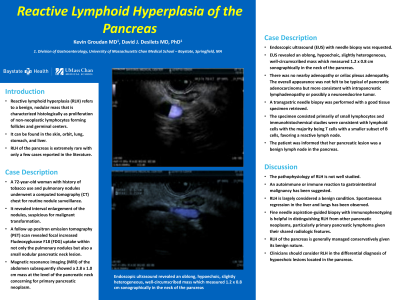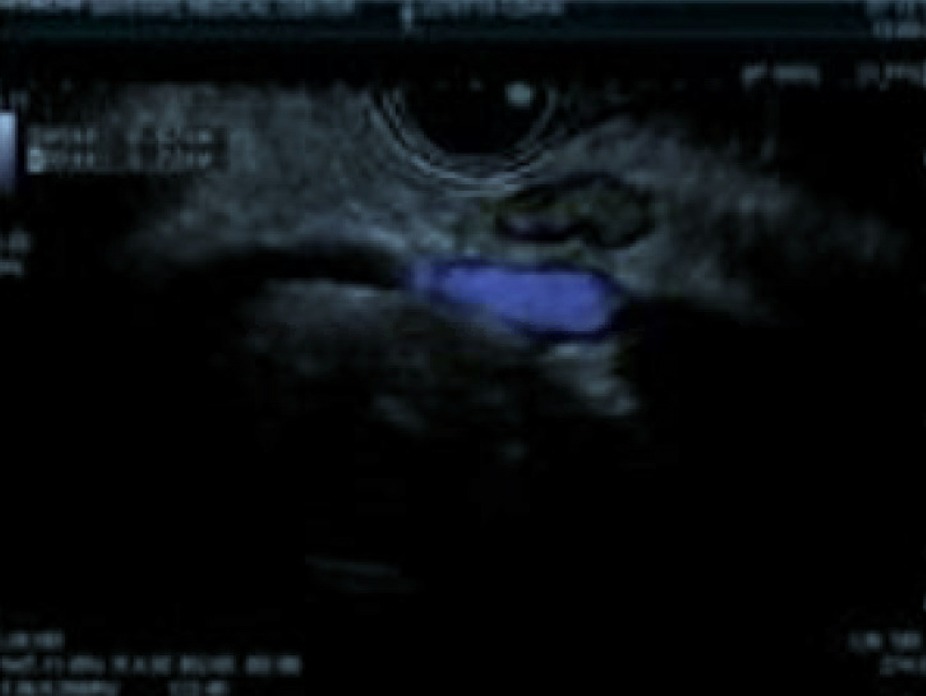Back


Poster Session C - Monday Afternoon
Category: Biliary/Pancreas
C0026 - Reactive Lymphoid Hyperplasia of the Pancreas
Monday, October 24, 2022
3:00 PM – 5:00 PM ET
Location: Crown Ballroom

Has Audio
.jpg)
Kevin Groudan, MD
University of Massachusetts Medical School - Baystate
Springfield, MA
Presenting Author(s)
Kevin Groudan, MD, David Desilets, MD
University of Massachusetts Medical School - Baystate, Springfield, MA
Introduction: Reactive lymphoid hyperplasia (RLH) refers to a benign, nodular mass that is characterized histologically as proliferation of non-neoplastic lymphocytes forming follicles and germinal centers. It can be found in the skin, orbit, lung, stomach, and liver. RLH of the pancreas is extremely rare with only a few cases reported in the literature.
Case Description/Methods: A 72-year-old woman with history of tobacco use and pulmonary nodules underwent a computed tomography (CT) chest for routine nodule surveillance. It revealed interval enlargement of the nodules, suspicious for malignant transformation. A follow up positron emission tomography (PET) scan revealed focal increased Fludeoxyglucose F18 (FDG) uptake within not only the pulmonary nodules but also a small nodular lesion in the pancreatic neck. Magnetic resonance imaging (MRI) of the abdomen subsequently showed a 2.8 x 1.0 cm mass at the level of the pancreatic neck concerning for primary pancreatic neoplasm. Endoscopic ultrasound (EUS) with needle biopsy was requested.
EUS revealed an oblong, hypoechoic, slightly heterogeneous, well-circumscribed mass which measured 1.2 x 0.8 cm sonographically in the neck of the pancreas (Figure 1). There was no nearby adenopathy or celiac plexus adenopathy. The overall appearance was not felt to be typical of pancreatic adenocarcinoma but more consistent with intrapancreatic lymphadenopathy or possibly a neuroendocrine tumor. A transgastric needle biopsy was performed with a good tissue specimen retrieved. The specimen consisted primarily of small lymphocytes and immunohistochemical studies were consistent with lymphoid cells with the majority being T cells with a smaller subset of B cells, favoring a reactive lymph node. The patient was informed that his pancreatic lesion was a benign lymph node in the pancreas.
Discussion: The pathophysiology of RLH is not well studied. An autoimmune or immune reaction to gastrointestinal malignancy has been suggested. RLH is largely considered a benign condition. Spontaneous regression in the liver and lungs has been observed. Fine needle aspiration-guided biopsy with immunophenotyping is helpful in distinguishing RLH from other pancreatic neoplasms, particularly primary pancreatic lymphoma given their shared radiologic features. RLH of the pancreas is generally managed conservatively given its benign nature. Clinicians should consider RLH in the differential diagnosis of hypoechoic lesions located in the pancreas.

Disclosures:
Kevin Groudan, MD, David Desilets, MD. C0026 - Reactive Lymphoid Hyperplasia of the Pancreas, ACG 2022 Annual Scientific Meeting Abstracts. Charlotte, NC: American College of Gastroenterology.
University of Massachusetts Medical School - Baystate, Springfield, MA
Introduction: Reactive lymphoid hyperplasia (RLH) refers to a benign, nodular mass that is characterized histologically as proliferation of non-neoplastic lymphocytes forming follicles and germinal centers. It can be found in the skin, orbit, lung, stomach, and liver. RLH of the pancreas is extremely rare with only a few cases reported in the literature.
Case Description/Methods: A 72-year-old woman with history of tobacco use and pulmonary nodules underwent a computed tomography (CT) chest for routine nodule surveillance. It revealed interval enlargement of the nodules, suspicious for malignant transformation. A follow up positron emission tomography (PET) scan revealed focal increased Fludeoxyglucose F18 (FDG) uptake within not only the pulmonary nodules but also a small nodular lesion in the pancreatic neck. Magnetic resonance imaging (MRI) of the abdomen subsequently showed a 2.8 x 1.0 cm mass at the level of the pancreatic neck concerning for primary pancreatic neoplasm. Endoscopic ultrasound (EUS) with needle biopsy was requested.
EUS revealed an oblong, hypoechoic, slightly heterogeneous, well-circumscribed mass which measured 1.2 x 0.8 cm sonographically in the neck of the pancreas (Figure 1). There was no nearby adenopathy or celiac plexus adenopathy. The overall appearance was not felt to be typical of pancreatic adenocarcinoma but more consistent with intrapancreatic lymphadenopathy or possibly a neuroendocrine tumor. A transgastric needle biopsy was performed with a good tissue specimen retrieved. The specimen consisted primarily of small lymphocytes and immunohistochemical studies were consistent with lymphoid cells with the majority being T cells with a smaller subset of B cells, favoring a reactive lymph node. The patient was informed that his pancreatic lesion was a benign lymph node in the pancreas.
Discussion: The pathophysiology of RLH is not well studied. An autoimmune or immune reaction to gastrointestinal malignancy has been suggested. RLH is largely considered a benign condition. Spontaneous regression in the liver and lungs has been observed. Fine needle aspiration-guided biopsy with immunophenotyping is helpful in distinguishing RLH from other pancreatic neoplasms, particularly primary pancreatic lymphoma given their shared radiologic features. RLH of the pancreas is generally managed conservatively given its benign nature. Clinicians should consider RLH in the differential diagnosis of hypoechoic lesions located in the pancreas.

Figure: Figure 1: Endoscopic ultrasound revealed an oblong, hypoechoic, slightly heterogeneous, well-circumscribed mass which measured 1.2 x 0.8 cm sonographically in the neck of the pancreas
Disclosures:
Kevin Groudan indicated no relevant financial relationships.
David Desilets indicated no relevant financial relationships.
Kevin Groudan, MD, David Desilets, MD. C0026 - Reactive Lymphoid Hyperplasia of the Pancreas, ACG 2022 Annual Scientific Meeting Abstracts. Charlotte, NC: American College of Gastroenterology.
